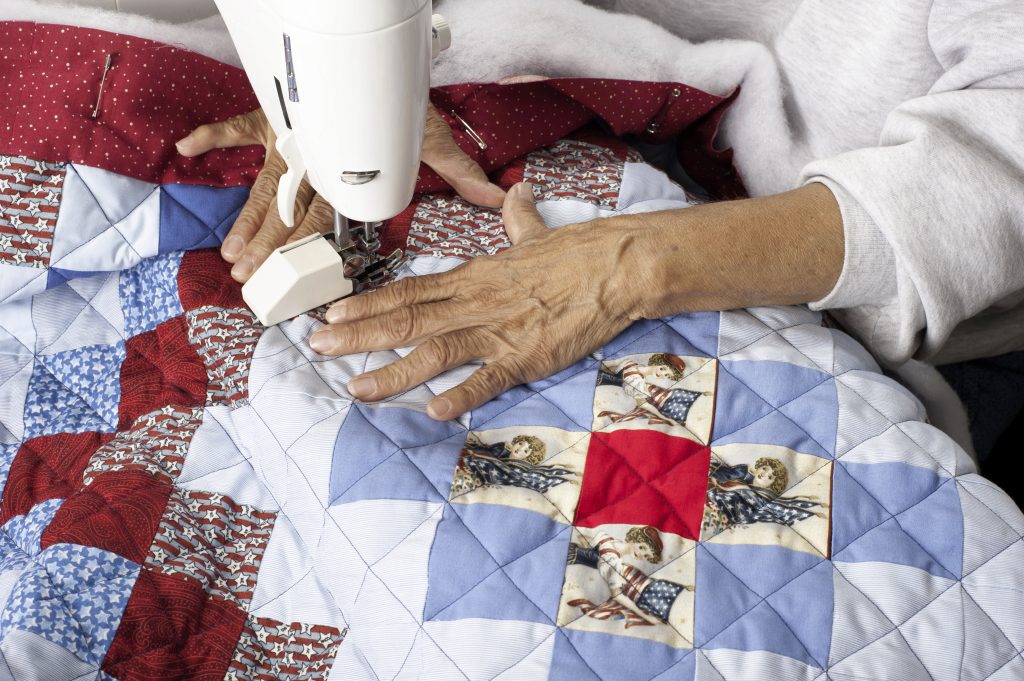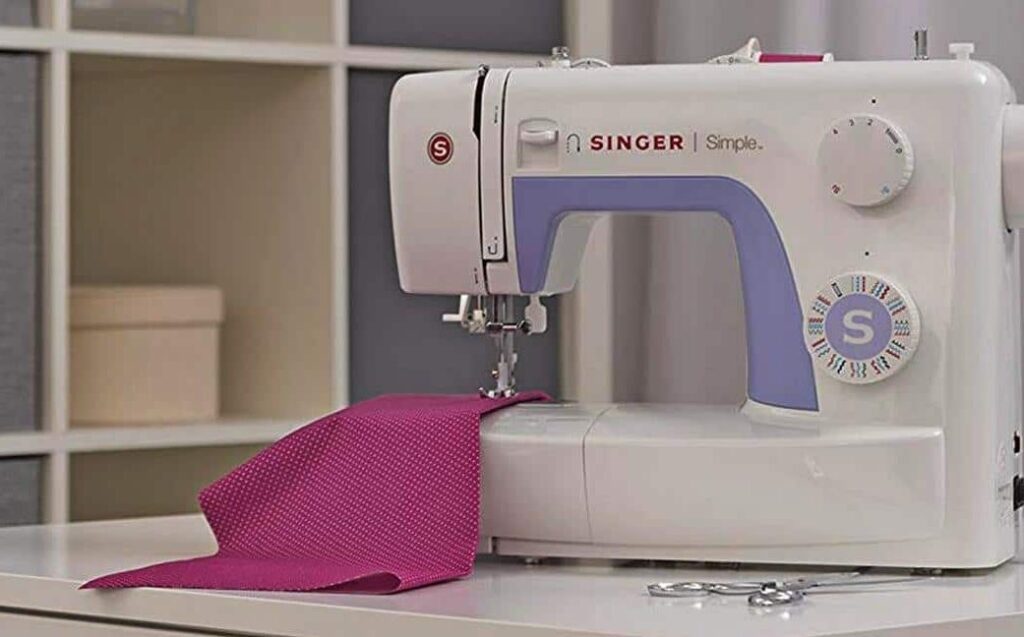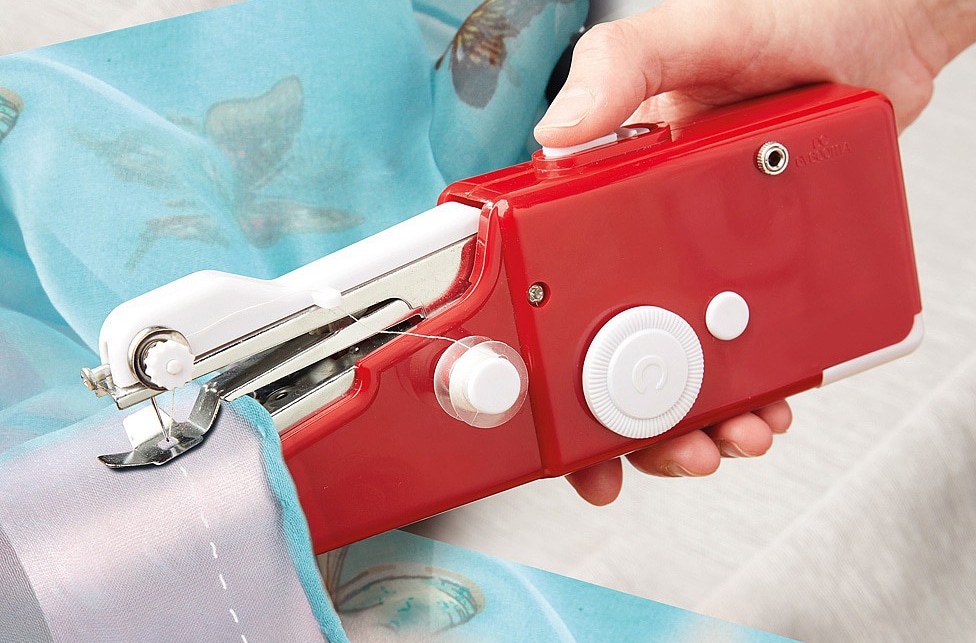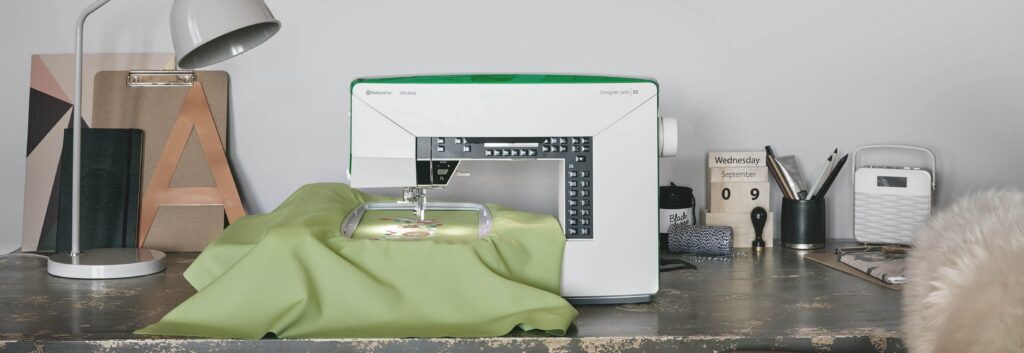Whether you will want to turn your favorite person’s old t-shirts or jerseys into the best memorabilia gift ever or want to work on your sewing, quilting can help. The best sewing machine for quilting can not only help ease the process of sewing two or more layers of fabric together, but it can also make sure that you have created that perfect thicker padded material suited for a quilt.
In our guide, we have highlighted the specific features that you need to know that can help you pick out the perfect sewing machine for quilting. In our review, we’ve considered the various features, like the size, the weight, the pre-set stitches quantity, maximum stitch length, and warranty to help you decide which one is right for you. Helping know the difference from one machine to another can definitely help narrow down your options and choose the best one.
Based on our hours of research looking through hundreds of sewing machines, we’ve come up with the best of the best. Not only will these machines ease the process—they were very much designed to specifically quilt. In our article today, we have a comparison table will all the best sewing machines on the market under one section, in-detail reviews of each product, which highlights every detail and how it can help you, and a buying guide to top it all off, which can help you with the final process.
More features: adjustable upper-thread tension, automatic stop/lock, memory function for stitch combinations, 7 presser feet and table included, LCD display screen, 850 spm speed, 163 mm free arm length
Used for quilting, specifically.
First, being computer-controlled is a must in this technological era. With its LCD display screen, adjustable upper-thread tension, and its automatic stop/lock, as well as its memory function for stitch combinations, it is completely automated and virtualized to make quilting easy.
The Ever Sewn Sparrow 30 is not only a functional machine, its a perfect tool to use, whether you’re a beginner or a more advanced, creative quilter.
Since it is equipped with everything you need, you’ll be able to use the 310 stitch patterns available. Of the 310 there, you’ll be able to pick from 32 utility choices, 84 decorative choices, and even a full alphabet in both script and block style.
All you need to do is set the width at 7 mm to get moving for decorative stitches. The memory function also comes in handy when working because the combinations you use can be saved. You can also enjoy the automatic thread-cuter and the adjustable presser foot pressure.
The Ever Sewn Sparrow 30 also comes with a sewing speed control, start/stop function and needle stop up/down, which truly sets it apart in the sewing machine market. The EverSewn Sparrow also includes seven standard presser feet(soles) and an extension table.
More features: dual LED lights, automatic needle threader, pressure adjustment, thread trimming foot control, extension table included, 10 pressing feet included, 900 spm speed
The Juki HZL-F600 comes from a high-quality brand name, since Juki sewing machines are ones of the most advanced and are recognized for their high-quality and durability. Equipped with 225 stitches, you’ll be able to choose which option you need best.
Equipped for not only quilting, you can also use the 16 professional buttonholes, 4 lettering fonts, and a huge selection of included accessories. You can also choose from a one-touch pattern selection from ten patterns—which also include applique stitch and blanket stitch.
You will also be able to adjust the cutting width with the Juki HZL-F600. This is very important with quilting because it is helpful with thicker fabrics.
The Juki HZL-F600 also has a quick-thread bobbin case to make sewing easier. The quick threading system with the automatic needle threader also can be used with just a push. You can also trim the top and bobbin threads in three different ways, with a push of a button, automatically programmed trims and with the foot-controlled trimming system. This makes it easy to use.
The Juki HZL-F600 is also a perfect sewing machine for advanced sewers, which has a variety of different options, from the up/down position, program automatic thread trimming, program a pattern or pattern sequence to stitch once or multiple times, program the foot control trimming, set the contrast on the LCD screen, change the volume on the machine buzzer, select from 8 languages settings, and open the on-board sewing guide.
More features: automatic needle threader, drop-in top bobbin, LCD screen
In our experience of testing sewing machines, we have realized that the simple ones tend to have the best stitches. This is certainly true of the Brother XR9550, which we found to have the most beautiful buttonhole and zigzag stitches we have seen.
The Brother XR9550 is of the many affordable sewing machines designed mainly for beginners and for basic use at home. It is a computerized sewing machine, but the different features such as stitch selection and needle threader have all been simplified to suit new users. Everything we did was very intuitive, even winding and installing the bobbin and changing stitch length and width.
More features: built-in needle threader, LED screen, automatic thread tension control, auto-declutch bobbin winder
The Janome DC2013 is the perfect sewing machine for beginners. Whether you are doing something simple like scrapbooking or if you are beginning your hand with quilting, this is a great machine.
It has fifty stitches available to use for built-in quilting. You can also enjoy the use of three, one-step buttonholes. This allows you to have the variety and options you need to create the perfect project.
As a beginner, you’ll want the convenience of all the various features of the Janome DC2013, like the auto-lock button, easy reverse, and a speed control slider. You’ll also want stability and dependability as you’re just getting started. This means that the sewing machine allows you to quilt with confidence and precision, with its automatic thread tension control, built-in needle threader, snap-on presser feet, memorized needle up/down, and its Superior Feed System (SFS).
You’ll also want the stocking stitch button, the easy reverse button, the auto-declutch bobbin winder, and even the extra high presser foot lift.
More features: snap-on presser feet, automatic presser foot pressure control, automatic tension, automatic locking stitch function, electronic auto pilot, 13 one-step buttonhole style options, built-in thread cutter
The SINGER Quantum Stylist 9960 is also another great sewing machine for a beginning designer who wants to quilt. Not only is it easy to use, it also is capable and equipped with using and putting a personal touch on your project.
You can choose form five different fonts and up to 600 built-in stitches, which is one of the most stitches out there. From mixed stitches to lettering, you can create unique stitch sequences for your quilts.
The SINGER Quantum Stylist 9960 also presents the option of being able to be mirror-imaged or elongated for creative options. The machine also comes equipped with the needle up/down feature, so you can pivot with ease while sewing, which you might be doing if you are topstitching, free-motion quilting, applique or more.
With the speed control, you can set the sewing speed on low, since that is the suggested speed for quilting—so you have maximum control. The Top Drop-in Bobbin on the SINGER Quantum Stylist 9960 makes threading not only easy to see but also easy to use while you’re sewing and working on your project.
After completing your project, a simple push of the Thread Trimmer Button will cut both the top and bottom thread, making projects like these simple and easy.
More features: 8 one-step auto-size buttonhole styles, automatic needle threader, backlit LCD display, adjustable sewing speed
The Brother HC1850 is another great machine not only for sewing, quilting, and basic monogramming, but also for transportation.
Since it is so lightweight, weighing only 13 lbs, you can easily take it anywhere. Not only is it highly portable—one of the most transportable on the market—it is also highly functional, with up to 130 unique stitches. Even though that is not the highest amount, it is still really impressive for a smaller machine.
With the Brother HC1850, you are in control of the speed. It is designed with flexibility and ease of use. Not only is it convenient because of the weight, it is also a handy machine for any level sewer because it has a built-in stitch reference flip-chart, an 8-presser feet, a push-button stitch selector, an adjustable sewing speed, automatic threading system, detachable foot controller, and an exceptional feed system for sewing on almost any fabric.
Some features that you won‘t see anywhere else which are unique to the Brother HC1850 include a detachable wide table, spring action quilting foot, and the ability to do free-motion quilting.
You can also always be in control, with its large backlit LCD display with intuitive push-button stitch selector and its other automatic features.
More features: stitch width and length adjustment, drop feed, front loading verticle oscilating hook bobbin, 5-piece feed dog
If you want the perfect machine to keep tucked away in your home, the Janome 2212 is a great, affordable choice.
With the entry-level model, you can get the use of up to 12 built-in stitches and a four-step buttonhole, which is the perfect package for any sewing beginner—especially if you are quilting.
You can also use the dial pattern selection found in the Janome 2212, and fiddle with the adjustable stitch width and length, which makes it extremely easy to use for beginners.
Something that is unique to quilting, the free arm and drop feed can make the machine as versatile as possible, which helps with all types of sewing, like quilting. Not only is it highly functional, it is also lightweight, at only 13 lbs.
The Janome 2212 also has a variety of different features making it unique and top-notch, like its snap on presser feet, its 5-piece feed dog, its push-pull bobbin winder, and its extra high presser foot lift.
You can also pick the program you want using just the simple stitch selection dial. Even though it is small and handy, you still can use the vertical oscillating hook bobbin or the two retractable, vertical spool pins.
More features: heavy duty metal frame, LED light, drop feed dog, 4 feet included, 1100 spm speed, Singer sewing assistant app, automatic needle threader
The Singer Heavy Duty 4432 is the perfect machine if you’re on a budget but still want to enjoy the hobby of sewing—or are looking to finish a quilting project.
It has 32 built-in stitches and a powerful motor for extra high sewing speed. You can choose between basic, stretch or decorative stitches to use for your from start to finish project, along with a one-step buttonhole for consistent results.
The Singer Heavy Duty 4432, as it mentions in its name, has a heavy duty metal frame for long lasting durability, and can whip up a project using denim or canvas. It even comes compatible with a SINGER Sewing Assistant App for lessons and tackling any project with ease.
The adjustable presser foot pressure makes it possible to adjust between sewing very lightweight sheers and decorator pillows and curtains.
The Singer Heavy Duty 4432 also comes with a built-in needle threader that helps ease that process, a top drop in bobbin, and a drop feed to make this a machine a must-have for quilters.
You can also switch from stitch to stitch with a flick of the wrist with the Stitch Selector Dial and the adjustable stitch length or width, which comes handing for appliqué and basting techniques.
Now that you’ve been introduced to the best sewing machines on the market, you might need some help with making your purchasing decision. We’ve created this buying guide to help you choose the machine with the best features for you.
Technically speaking, any sewing machine can get the job done. However, if you’re going to be specifically quilting, there are some unique features that make the job much easier.
For one, these quilting machines will have much wider tables to work with. The width and depth of the machines are specifically set for quilting.
You can also enjoy the benefit of being able to customize your options. If you’re looking to embroider or use specific fonts, you can easily flip a switch in a number of options to really take advantage of the machine on a creative level.
You’ll also be able to thread much easier than a regular machine. Especially with quilting, you might be prompted to switch up your stitch instantly—these quilting machines make it easy, with some models, like the SINGER Quantum Stylist 9960, you can even switch mid-stream.
They also have strong thread tension, which can power through up to four layers of material.

When making a quilt, you’ll have to familiarize yourself with its four major components: the top, the batting, the backing, and the binding.
The top is the part you often see, with the different pieces of fabrics, colors, and patterns.
The batting is the loft, warmth, and bulk of the quilt. If you look at the quilt like an Oreo—it’s the stuffing. With this component, you’ll be prompted to choose in the thickness and the material. Normally, people either choose wool, cotton, and polyester.
The backing is the bottom of the Oreo, and the binding is the same as a book—it’s the part where you close the quilt up. You can choose between making it hand-stitched, machine-stitched, satin, solid, patterned, cotton or even frills.
Different Techniques
To make your quilt, you will be able to choose from three different techniques: piecing, applique, and free-motion.
Piecing: Just like the name suggests, you’ll be attaching small pieces of fabric and weave it together for a certain pattern. You can work with chain piecing (which is the most basic patchwork quilt) or English paper piecing, among many other options.
Applique: Instead of piecing something together, this technique has you connecting fabric pieces directly to another fabric piece.
Free-Motion Quilting: You can not only patch up some quilt pieces together, but you can also add much more creative aspects to your quilt—like words or designs.
Now that you know a little bit more about quilting, it’s time for you to familiarize yourself on using your quilting machine.
Once you purchase your quilt sewing machine, you’ll want to oil it. To have the perfect quilt, you’ll want a smooth sewing machine. You can either pour the oil in a hole or you’ll need to oil the different parts on a separate basis.
Once it’s smooth, you should place your machine properly. The corner of the room is perfect. Make sure that you can reach the foot controller or have it placed so you can reach around with the hand controller.
Once it’s set up, you’ll need to lower the SPM, which is the stitching rate. This will allow you to get through that dense fabric.
After setting the SPM, you’ll want to select the proper foot. You need a special foot for those thick quilt. The Darning foot is best, also called free motion foot or hopping foot.
After getting the proper foot, lower the feet dog. This might sound strange, however, it’s necessary for quilting performance. With this step, you’ll be able to hold the cloth more efficiently and securely.
To quilt properly, you’ll need to decrease the stitch length to have the proper attachment consistency. When you do this, along with stopping the thread cutter, you’ll then be able to leave the thread-trimming until after you’ve finished your quilt.
Make sure that you have your stitch plate selected to using only one needle and then you’re ready to go!
As you work on your first quilt, keep these tips in mind:
Before you buy, you’ll definitely need to check a few things off your list—not only if they are there or not but also the specific details labeled underneath the theme.
The size of your sewing machine will make a huge difference while you’re quilting. Not only should it fit the space you have in your home, a lightweight machine, like the Janome 2212, might be a great solution instead of heaving the machine around the house.
The throat is the length of the arm and how it impacts the work area, which is that space on the right of the needle. This is where most quilting machines differ—offering you much larger space.
If you have a high stitch function, like the SINGER Quantum Stylist 9960, with 600, you will be able to freehand the quilt a lot better. You can create more complex designs and really practice working with stitch length and width adjusting.
The stitching rate, or the SPM, is also an important feature. You can easily start off with a low SPM if you’re a beginner and work your way up. (Especially with quilting, you’ll need a lower rate since the lines are normally curved.

You’ll definitely want a machine that has an ease of changing thread, since you’ll be using so many different types while quilting (normally three—for each part). Automated threading, like the one found on the Janome DC2013, can help with your time and your eyesight.
If you want the most workspace available, the long arm quilting machines are your best options. You can also use a frame, which will move around the fabric, which is much better than moving the fabric through the machine.
You can choose a Quarter-Inch Foot, which is ideal for a quilt top to turn the corner swiftly and accurately. The free motion or darning foot has a much bigger opening for the needle and with the spring also included, it’s perfect to make adjustments on the fly.
Especially if you really get entranced in your project, the sound and noise fo your machine can make a difference between sewing being enjoyable for you and irritating your entire family—or your neighbors. Make sure to check out if the sewing machine you’re looking at can be noisy.
Some other advanced features to check out on the best sewing machine for quilting for you will be stitch width and length adjustment, drop feed, front-loading vertical, and an oscillating hook bobbin.
You might also enjoy adjustable upper-thread tension, automatic stop/lock, memory function for stitch combinations, and an LCD display screen.
Even our budget-friendly choice, the Singer Heavy Duty 4432 has a 25-year limited warranty. Make sure that since you’re not only making the investment in the machine but also on the hobby itself, that you’ll have the warranty on the machine to back it up.
Especially if you have those years of warranty on your machine, you’ll want to keep up with maintenance so that your machine not only lasts that long but also works properly.
To keep your machine running properly throughout the years, make sure you are:
Using your cover. Try your best to avoid the machine catching dust, since it can negatively affect your machine. When you’re not using your sewing machine, keep it covered.
Always properly clean it. When used regularly, the suggestion is to clean your machine, part-by-part, every three months.
Purchase proper and adequate accessories. Especially if you are a more advanced sewer, you’ll want quality accessories to back it up. This will also help out with durability through quality threads and the manufacturer prescribed needle.
Keep your machine oiled. Whether you’re pouring oil in the designated hole or doing it part-by-part, you’ll want to use an adequate amount of oil to lubricate it.
Remove lint consistently. Just like your dryer, you’ll need to take away that lint that bulks up and can jam your machine.
When it comes to carrying and transporting machine (for example, if you have a sewing class), you can rely on the bag that some machines come with. The Everything Mary Deluxe Sewing Machine Tote bag, for example, is the perfect bag to be able to not only carry your sewing machine but add on all of its accessories.
If you want to choose the best sewing machine for you and want to skip all the extra reading, here are our top three picks:
The Ever Sewn Sparrow 30 is our Editor’s Choice for the best sewing machine for quilting. Period. With up to 310 built-in stitches to choose from and weighing just 17 lbs, you can easily carry this machine wherever you go. It also has a 10-year warranty on mechanical parts, along with various features that make this machine a serious go-to for any level quilter.
The Juki HZL-F600 is the perfect choice for advanced sewers. Along with its 225 built-in stitches, this machine has a lot of other features that make it suitable for advanced possibilities, like the automatic needle threader, pressure adjustment, thread trimming foot control, extension table included, 10 pressing feet included, and 900 spm speed.
Finally, the Singer Heavy Duty 4432 is the perfect fit if you find yourself on a budget and still want to take on sewing a quilt for your personal project. Weighing only 17 lbs and perfectly equipped with up to 32 built-in stitches, the 25-year limited warranty puts this machine over the edge. Regardless of its affordable price, it still comes with various quality features, like its heavy duty metal frame, LED light, drop feed dog, 4 feet included, 1100 spm speed, Singer sewing assistant app, and its automatic needle threader.
Whether you are a beginner or more advanced sewer, we hope that this guide has helped you pick out the best sewing machine for quilting for you or a loved one.





